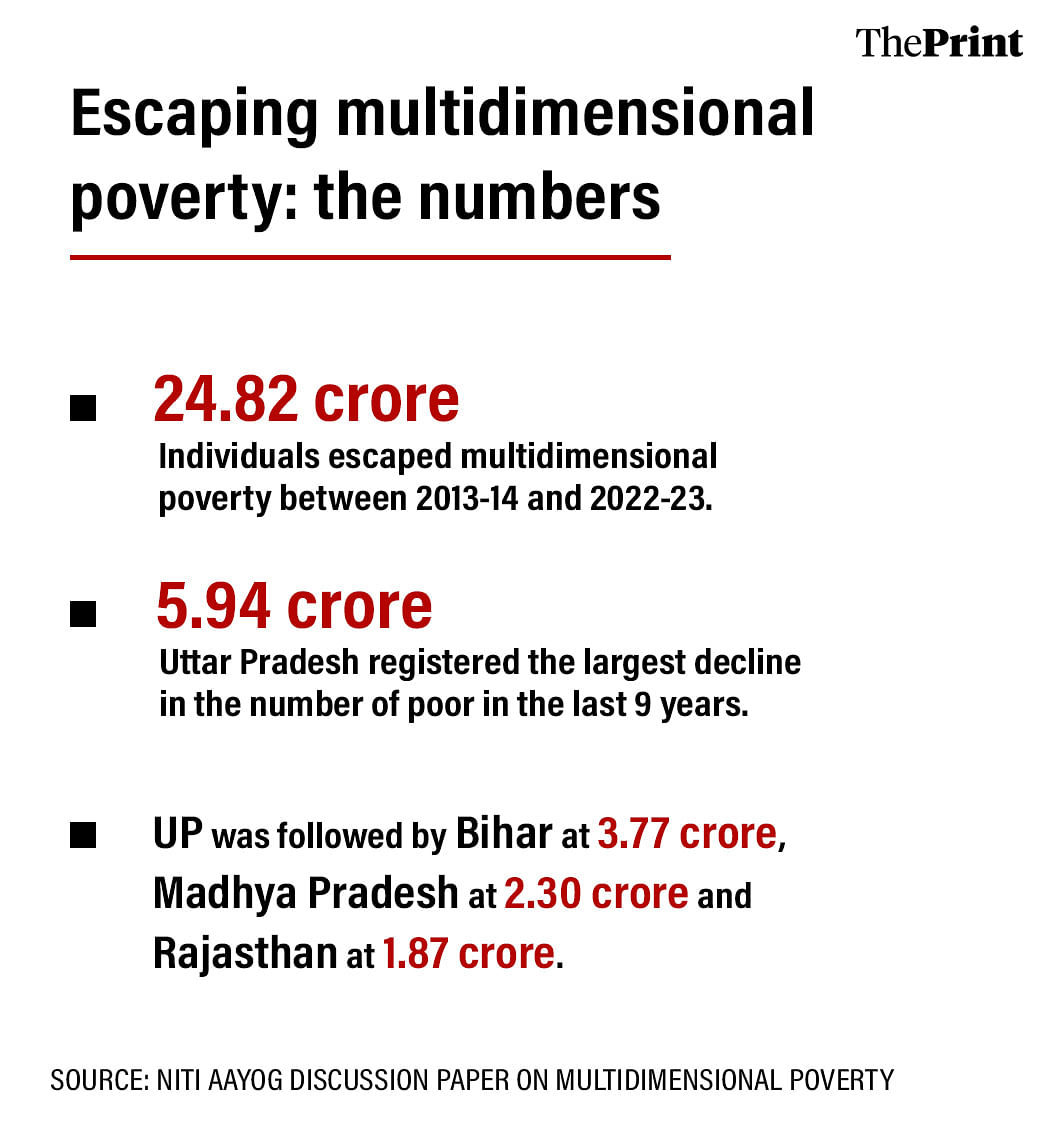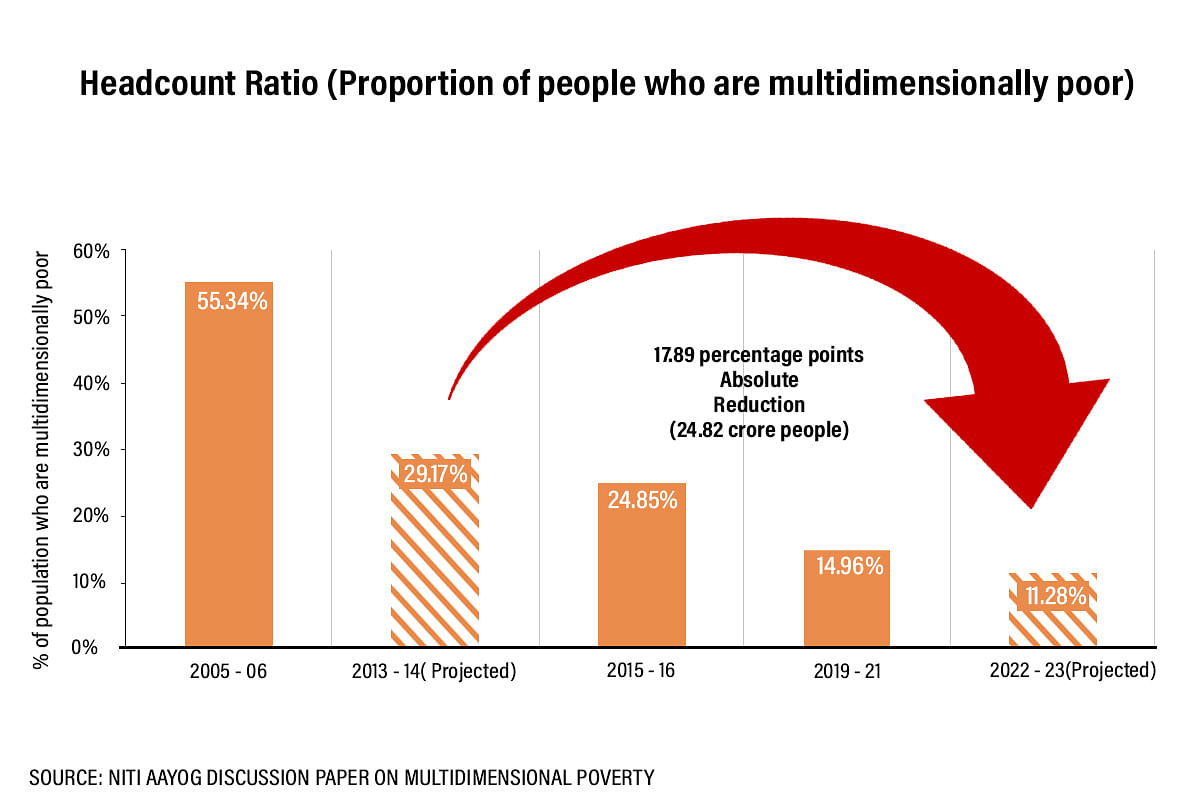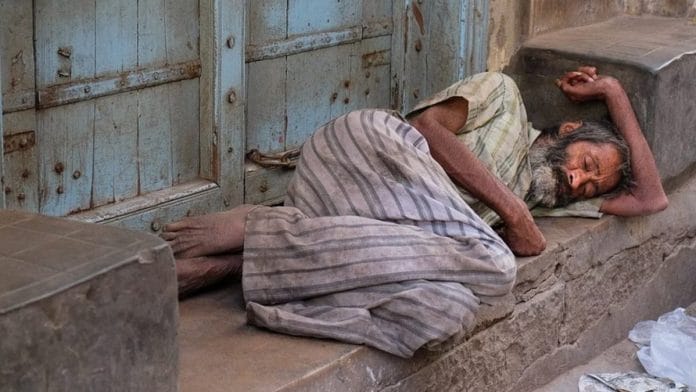New Delhi: An estimated 24.82 crore Indians have moved out of multidimensional poverty in the last nine years, with poverty levels declining to 11.28 percent in 2022-23 from 29.17 percent in 2013-14 — a reduction of 17.89 percentage points — according to a discussion paper released by NITI Aayog Monday.
The paper on ‘Multidimensional Poverty in India since 2005-06’ was released by Professor Ramesh Chand, member, NITI Aayog in the presence of B.V.R. Subrahmanyam, CEO NITI Aayog.
The paper has been written by Chand and Dr Yogesh Suri, senior adviser in the federal think tank. Oxford Policy and Human Development Initiative and the United Nations Development Programme (UNDP) have provided technical inputs for it.
The Multidimensional Poverty Index (MPI) is a globally recognised way to capture poverty in multiple dimensions beyond monetary aspects. It is a metric of “deprivations” faced by households across health, education and standard of living that are represented by 12 Sustainable Development Goals-aligned indicators.

The indicators include nutrition, child and adolescent mortality, maternal health, years of schooling, school attendance, cooking fuel, sanitation, drinking water, electricity, housing, assets, and bank accounts. All the 12 indicators have recorded significant improvement during the last nine years.
The paper estimated multidimensional poverty in India for the years 2005-06, 2015-16, and 2019-21 using data from the corresponding National Family Health Survey (NFHS) round three to five. It says that 55.34 percent — more than half of India’s population — were multidimensionally poor in 2005-06.
The proportion of such poor persons in the total population has fallen to 29.17 percent in 2013-14 from 55.34 percent in 2005-06 — a reduction of 26.17 percentage points.
But the paper states that the pace of decline in poverty headcount ratio using the exponential method was much faster between 2015-16 and 2019-21 (10.66 percent annual rate of decline) compared to the period between 2005-06 and 2015-16 (7.69 percent annual rate of decline).
Subrahmanyam said that the paper extrapolated the trend using an exponential method as it is mathematically more defensible, which was done in consultation with UNDP and Oxford. “The government has a goal to bring multidimensional poverty to below 1 percent. All efforts are being made in that direction,” he added.
The paper states that India will reach single-digit poverty levels during 2024 itself.
According to him, the reduction in poverty has mainly been achieved because of two factors. “One is an improvement in governance and delivery. And two, more and more targeted schemes being launched literally get mapped onto each of your indicators. That’s why the impact is visible much more. The rate is somehow being correlated with the number of programs, which are directed at each of the indicators. There is a scheme targeting each of the 12 MPI indicators,” he said.
The Modi government had launched several initiatives targeting the poor, such as free food grain distribution under Pradhan Mantri Garib Kalyan Anna Yojana, houses for the poor under PM Awas Yojana, direct benefit transfer through Pradhan Mantri Jan Dhan Yojana and various programmes addressing maternal health, clean cooking fuel distribution through Ujjwala Yojana, improved electricity coverage via Saubhagya, among others since coming to power in 2014.
Also Read: How globalisation in last quarter century has coincided with falling inequality & poverty in India
UP registered largest decline in the number of poor
Among the states, Uttar Pradesh registered the largest decline in the number of poor with 5.94 crore people moving out of poverty in the last nine years, followed by Bihar, Madhya Pradesh and Rajasthan, where 3.77 crore, 2.30 crore and 1.87 crore individuals, respectively, escaped poverty during the same period.
The discussion paper also examined the indicator-wise performance between the three NFHS surveys to analyse the reduction in deprivation across various domains.
It showed that the highest levels of deprivation in 2005-06 were found in indicators such as cooking fuel (74.40 percent), sanitation (70.92 percent) and bank accounts (58.11 percent). On the other hand, child and adolescent mortality (4.84 percent), school attendance (21.27 percent) and drinking water (21.34 percent) had the lowest levels of deprivation during the same period.

According to Chand, with the poverty level coming down, India is likely to achieve the Sustainable Development Goals (SDG) 1.2 target of reducing at least half the proportion of men, women and children of all ages living in poverty in all dimensions by 2030.
To assess the poverty levels in the year 2013-14 against the current scenario (i.e. for the year 2022-23), projected estimates have been used due to data limitations for these specific periods, the paper said.
Chand said that the rate of decline in multi-dimensional poverty has been possible mainly on account of a large number of initiatives/schemes of the government targeted at improving specific deprivation aspects.
According to the paper, the states with higher poverty incidence have witnessed higher reductions in headcount ratio poverty over the years, indicating that inter-state multidimensional poverty differentiates across various states have declined over the years.
However, the paper noted that the reduction in poverty may differ, as various factors and externalities can influence the pace and trajectory of poverty alleviation efforts. The pace of reduction is generally faster when poverty levels are higher than when these levels are lower. The method used for extrapolation, based on the rate of decline rather than percentage point decline, takes care of this to an extent.
Besides, since part of the NFHS-5 data were collected before the pandemic, the estimates presented in the paper may not fully reflect the impact of Covid-19 on the economy or the implications of subsequent government interventions.
(Edited by Richa Mishra)
Also Read: 2 things that can make India a $10 trillion economy—and beat the ‘poverty veto’






